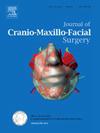Volumetric stability of biphasic hap/β-tcp/collagen implants in malar augmentation: A CBCT-Based case series after orthognathic surgery
IF 2.1
2区 医学
Q2 DENTISTRY, ORAL SURGERY & MEDICINE
引用次数: 0
Abstract
Objective
Evaluate volumetric stability and symmetry of Biphasic Hydroxyapatite (HAp)/β-Tricalcium phosphate (β-TCP)/collagen (BCP-collagen) implants in malar augmentation post-orthognathic surgery over one year using Cone-Beam-CT (CBCT) and explore influencing factors.
Methods
Retrospective case-series analysis of 45 patients (38 females) who underwent bimaxillary orthognathic surgery with malar augmentation using BCP-collagen implants. CBCT scans were taken at 1 week, 4 months, and 12 months post-surgery. Regression analysis explored potential factors influencing volume loss, including age and sex (p < 0.05).
Results
Median patient-age was 26 years (IQR: 22–32). One week postoperatively, median implant-volume was 1356.70 mm3 (SD = 5888.53). By four-months, it decreased to 985.46 mm3 (SD = 4352.47), a 25.4 % reduction (p < 0.001). Afterwards, a 1.3 % volume decrease (p = 0.42). Volume loss varied between 35.1 and 14.7 %. Asymmetry >7 % was observed in 17.7 % of patients. No significant differences in volume loss were found between sexes (p = 0.6) or age groups (p > 0.9). Regression showed no significant associations with age (β = 0.02, 95 %CI: −0.48, 0.53, p > 0.9) or sex (β = 11, 95 %CI: −30, 52, p = 0.6).
Conclusion
BCP-collagen implants exhibit early volume loss but stabilise long-term. High variability and asymmetry in volumetric changes challenge standard overcorrection strategies, emphasising the need for early monitoring. CBCT enables precise volumetric assessment and may improve surgical decision-making.
双相hap/β-tcp/胶原植入体隆胸的体积稳定性:正颌手术后基于cbct的病例系列。
目的:利用锥形束ct (cone - beam ct, CBCT)评价双相羟基磷灰石(HAp)/β-磷酸三钙(β-TCP)/胶原(bcp -胶原)假体在正颌术后一年多的隆胸手术中的体积稳定性和对称性,并探讨影响因素。方法:回顾性分析45例(女性38例)采用bcp -胶原种植体行双颌正颌隆胸手术的患者。分别于术后1周、4个月和12个月进行CBCT扫描。回归分析探讨了影响体积损失的潜在因素,包括年龄和性别(p)。结果:患者年龄中位数为26岁(IQR: 22-32)。术后1周,中位种植体体积为1356.70 mm3 (SD = 5888.53)。4个月后,减少到985.46 mm3 (SD = 4352.47), 17.7%的患者减少25.4% (p < 7%)。体积损失在性别(p = 0.6)和年龄组(p = 0.9)之间无显著差异。回归显示,年龄(β = 0.02, 95% CI: -0.48, 0.53, p = 0.9)和性别(β = 11, 95% CI: -30, 52, p = 0.6)无显著相关性。结论:bcp -胶原种植体早期体积损失,但长期稳定。体积变化的高度可变性和不对称性挑战了标准的过度校正策略,强调了早期监测的必要性。CBCT能够精确评估体积,并可能改善手术决策。
本文章由计算机程序翻译,如有差异,请以英文原文为准。
求助全文
约1分钟内获得全文
求助全文
来源期刊
CiteScore
5.20
自引率
22.60%
发文量
117
审稿时长
70 days
期刊介绍:
The Journal of Cranio-Maxillofacial Surgery publishes articles covering all aspects of surgery of the head, face and jaw. Specific topics covered recently have included:
• Distraction osteogenesis
• Synthetic bone substitutes
• Fibroblast growth factors
• Fetal wound healing
• Skull base surgery
• Computer-assisted surgery
• Vascularized bone grafts

 求助内容:
求助内容: 应助结果提醒方式:
应助结果提醒方式:


